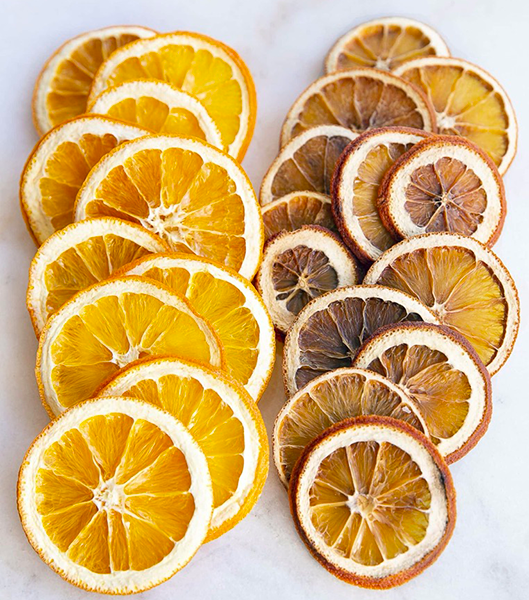
Content Menu
● Understanding Food Dehydration
● Benefits of Dehydrating Oranges
● How to Dehydrate Oranges in a Food Dehydrator
>> Step 1: Selecting Your Oranges
>> Step 2: Preparing the Oranges
>> Step 3: Arranging the Slices
>> Step 4: Setting the Temperature
>> Step 5: Dehydrating Time
>> Step 6: Cooling and Storing
● Creative Uses for Dried Oranges
● Health Benefits of Oranges
● Tips for Successful Dehydration
● Common Mistakes to Avoid
● Expanding the Article Further
>> 1. Detailed Nutritional Information:
>> 2. Step-by-Step Visual Guide:
>> 3. Recipes Using Dried Oranges:
>> 4. Culinary Pairings:
>> 5. Cultural Significance & History:
>> 6. Environmental Impact & Sustainability:
>> 7. Personal Anecdotes & Tips from Experts:
● Conclusion
● FAQ
>> 1. Can I dehydrate other citrus fruits using the same method?
>> 2. What should I do if my orange slices are still sticky after drying?
>> 3. How should I store my dried orange slices?
>> 4. Can I use an oven instead of a dehydrator?
>> 5. Are there any health benefits associated with eating dried oranges?
● Citations:
Dehydrating oranges is a popular method for preserving this vibrant fruit while intensifying its flavor. Using a food dehydrator is one of the most effective ways to achieve perfectly dried orange slices, which can be used in various culinary applications, from snacks to garnishes. This article explores the process of dehydrating oranges, the benefits of using a food dehydrator, and answers some frequently asked questions about this method.

Understanding Food Dehydration
Food dehydration is a preservation technique that removes moisture from food, inhibiting the growth of bacteria, yeast, and mold. A food dehydrator operates at low temperatures, typically between 85°F and 160°F (29°C to 71°C), which helps maintain the food's nutritional value while extending its shelf life.
The dehydration process involves circulating warm air around the food, allowing moisture to evaporate gradually. This method is particularly advantageous for fruits like oranges because it retains their natural flavors and nutrients without the need for preservatives.
Benefits of Dehydrating Oranges
Dehydrating oranges offers several benefits:
- Extended Shelf Life: Dried oranges can last for months or even years when stored properly, making them a convenient option for long-term storage.
- Nutrient Retention: The dehydration process preserves many of the vitamins and minerals found in fresh oranges.
- Versatile Uses: Dried orange slices can be used in teas, cocktails, baked goods, or as a healthy snack.
- Reduced Waste: Dehydrating allows you to use surplus oranges before they spoil.
How to Dehydrate Oranges in a Food Dehydrator
Step 1: Selecting Your Oranges
Choose ripe, seedless oranges for the best results. Smaller oranges are often easier to slice and fit better on dehydrator trays.
Step 2: Preparing the Oranges
1. Wash: Rinse the oranges thoroughly under running water to remove any pesticides or dirt.
2. Slice: Use a sharp knife or mandoline slicer to cut the oranges into uniform slices about 1/4 inch thick. Thinner slices will dehydrate faster.
3. Pat Dry: If desired, pat the slices with a paper towel to remove excess juice, which can speed up the drying process.
Step 3: Arranging the Slices
Place the orange slices in a single layer on the dehydrator trays. Ensure that they do not overlap to allow for proper air circulation.
Step 4: Setting the Temperature
Set your food dehydrator to 135°F (57°C), which is ideal for drying fruits.
Step 5: Dehydrating Time
The drying process can take anywhere from 6 to 12 hours depending on the thickness of your slices and your specific dehydrator model. It's important to check periodically; they are done when they are dry but still slightly pliable and translucent.
Step 6: Cooling and Storing
Once dried, let the orange slices cool completely before storing them in airtight containers or mason jars. This prevents moisture from being trapped inside, which could lead to spoilage.

Creative Uses for Dried Oranges
Dried orange slices are incredibly versatile:
- Snacking: Enjoy them as a healthy snack on their own.
- Beverages: Add them to teas or cocktails for added flavor and decoration.
- Baking: Incorporate them into muffins or cakes for a citrusy twist.
- Garnishing: Use dried orange slices as decorative garnishes for desserts or cheese boards.
Health Benefits of Oranges
Oranges are not only delicious but also packed with health benefits:
- Rich in Vitamin C: One medium orange provides about 70 mg of vitamin C, which is essential for immune function and skin health.
- Antioxidants: Oranges contain flavonoids that help combat oxidative stress and inflammation in the body.
- Dietary Fiber: Dried oranges retain fiber content, promoting digestive health and aiding in weight management.
- Low Calorie Snack: Dried orange slices are low in calories compared to many processed snacks, making them an excellent choice for healthy eating.
Tips for Successful Dehydration
To ensure you achieve optimal results when dehydrating oranges:
- Uniform Slices: Aim for uniform thickness when slicing; this ensures even drying.
- Rotate Trays: If your dehydrator has multiple trays, rotate them halfway through drying to promote even airflow and drying.
- Test for Doneness: The best way to test if your oranges are done is by checking their texture; they should be dry but still slightly pliable without any sticky spots.
- Conditioning Dried Fruit: After drying, condition your orange slices by placing them in a large container and shaking gently every day for about a week. This helps redistribute any remaining moisture evenly among the slices.
Common Mistakes to Avoid
While dehydrating oranges is straightforward, there are common pitfalls:
- Overcrowding Trays: Avoid placing too many slices on one tray; overcrowding can lead to uneven drying and spoilage.
- Not Checking Regularly: Failing to check your fruit periodically can result in over-drying or under-drying; set reminders to check every few hours during the drying process.
- Ignoring Storage Conditions: Store dried fruit in airtight containers away from light and heat sources; improper storage can lead to moisture absorption and spoilage.
Expanding the Article Further
To reach over 1800 words while maintaining quality content about dehydrating oranges using a food dehydrator, we can delve deeper into several aspects:
1. Detailed Nutritional Information:
- Provide an extensive breakdown of vitamins and minerals found in oranges.
- Discuss how dehydration affects nutritional content compared to fresh consumption.
2. Step-by-Step Visual Guide:
- Include images at each step of preparing and dehydrating oranges.
- Provide video links demonstrating the process visually.
3. Recipes Using Dried Oranges:
- Share specific recipes that incorporate dried orange slices.
- Suggest creative ways to use dried oranges beyond snacking.
4. Culinary Pairings:
- Discuss what flavors pair well with dried orange slices (e.g., chocolate, nuts).
- Suggest drinks that complement dried oranges (e.g., herbal teas).
5. Cultural Significance & History:
- Explore how different cultures use dried fruits historically.
- Discuss any traditional dishes that include dried citrus fruits.
6. Environmental Impact & Sustainability:
- Talk about how making your own dried fruits reduces waste compared to buying packaged snacks.
- Highlight sustainable practices when sourcing oranges (e.g., organic farming).
7. Personal Anecdotes & Tips from Experts:
- Include quotes or tips from chefs or nutritionists on using dried fruits effectively.
- Share personal experiences regarding successes or challenges faced when dehydrating fruits at home.
Conclusion
Dehydrating oranges in a food dehydrator is an easy and effective way to preserve this delicious fruit while enhancing its flavor. The process not only extends shelf life but also retains essential nutrients, making it an excellent choice for health-conscious individuals. By following simple steps and utilizing a food dehydrator, you can create delightful dried orange slices that can be enjoyed in various culinary applications.

FAQ
1. Can I dehydrate other citrus fruits using the same method?
Yes! You can dehydrate lemons, limes, tangerines, and grapefruits using similar methods as with oranges. Just adjust slicing thickness based on fruit size.
2. What should I do if my orange slices are still sticky after drying?
If your orange slices feel sticky or moist after drying, return them to the dehydrator for an additional hour or until they reach your desired dryness level.
3. How should I store my dried orange slices?
Store dried orange slices in airtight containers in a cool, dark place. Proper storage can keep them fresh for several months.
4. Can I use an oven instead of a dehydrator?
Yes! You can dehydrate oranges in an oven set at low temperatures (around 200°F) but be sure to monitor them closely as ovens can dry out foods faster than dehydrators.
5. Are there any health benefits associated with eating dried oranges?
Yes! Dried oranges retain many nutrients found in fresh fruit and provide dietary fiber while being low in calories compared to many processed snacks.
Citations:
[1] https://fooddehydratorrecipes.com/how-to-dehydrate-oranges/
[2] https://hildaskitchenblog.com/recipe/dehydrated-oranges-dehydrator-and-oven-directions/
[3] https://www.midwestlifeandstyle.com/simple-guide-to-making-dried-oranges-in-a-dehydrator-for-christmas/
[4] https://www.ellaclaireinspired.com/dried-orange-slices/
[5] https://artofnaturalliving.com/dried-orange-slices-how-to-make-and-use/
[6] https://juliedaviesflowerworkshops.co.uk/portfolio/making-dried-oranges-in-a-food-dehydrator/
[7] https://www.stonegableblog.com/the-best-way-to-dry-oranges-so-they-stay-vibrant/
[8] https://www.chefnotrequired.com/dehydrated-orange-slices/
[9] http://natures-powerhouse.co.uk/oranges/
[10] https://www.thepurposefulpantry.com/dehydrate-oranges/











